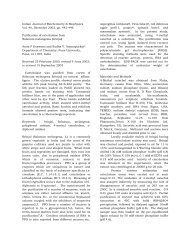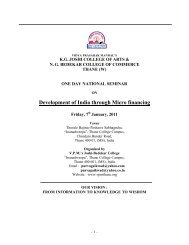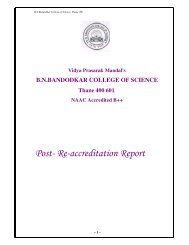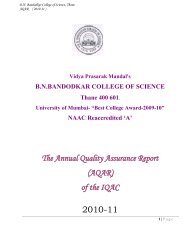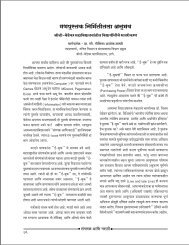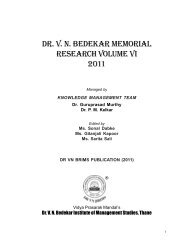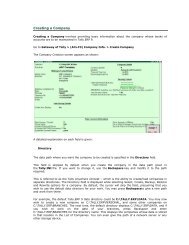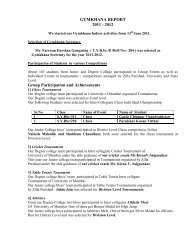Haemoglobin.
Haemoglobin.
Haemoglobin.
Create successful ePaper yourself
Turn your PDF publications into a flip-book with our unique Google optimized e-Paper software.
B.N. Bandodkar College of Science, Thane<br />
Zoology – II<br />
Haematology<br />
By N.N.Patil<br />
<strong>Haemoglobin</strong>.<br />
Structure, Synthesis Functions & Degradation.<br />
<strong>Haemoglobin</strong> is a respiratory pigment found in red blood corpuscles.<br />
<strong>Haemoglobin</strong> is a conjugated protein, synthesized inside immature<br />
erythrocyte in the red bone marrow.<br />
It consists of two components Haem And Globin. Haem , an Iron<br />
and porphyrin compound is 4% and Globin (amino acids) is 96%.<br />
<strong>Haemoglobin</strong> gives red colour to the blood.<br />
Structure of <strong>Haemoglobin</strong> :-<br />
In <strong>Haemoglobin</strong> A haem group consists of an iron (Fe) ion (charged<br />
atom) held in a heterocyclic ring, known as a porphyrin.<br />
This porphyrin ring or protoporphyrin compound consists of four<br />
pyrrole molecules cyclically linked together by methane bridges.<br />
The protoporphyrin compound combines with metal iron forming<br />
metalloporphyrin, where metal iron is 0.34%. Fe is in ferrous state<br />
The iron ion, which is the site of oxygen binding, coordinates with the<br />
four nitrogens in the center of the ring, which all lie in one plane.<br />
3) The Globin of each Hb mole consist of a tetramers with two<br />
polypeptide chains of one kind & two of another . Globin helps heam<br />
to keep iron in ferrous state & combine loosely & reversibly with O2. In
normal adult Hb i.e. in HbA-these chains are called α and β chains and<br />
HbA2 –α and δ chain are present. Each chain is composed of a sequence<br />
of about 150 amino acids. The substitution of any one these amino acids<br />
by another, results in formation of abnormal chain and abnormal Hb e.g.<br />
in Hb-S which is found in sickle cell anemia, glutamic acid( amino acid)<br />
is replaced by Valine, when exposed to hypoxic condition Hb-S<br />
produces long crystals called tactoid in the red cells.<br />
Globin<br />
Haem------<br />
Iron ( Ferrous state)<br />
Haem -------------<br />
Protoporphyrin( 4 pyrrols)
Synthesis of <strong>Haemoglobin</strong> :- Synthesis of <strong>Haemoglobin</strong> begins at the<br />
erythroblast stage & continues through normoblast & reticulocyte .<br />
Synthesis occurs in the ribosome of endoplasmic reticulum.<br />
Haem portion of <strong>Haemoglobin</strong> is synthesized in the following steps:<br />
Formation of Haem<br />
1) Acetic acid in Krebs cycle changes in to α- Keto glutaric acid which<br />
combines with Glycine to form Pyrrole compound.<br />
2) 4 Pyrrole compounds combine to form Protoporphyrin III<br />
compound.<br />
3) Protoporphyrin III + Fe ---------Haem (Metallopophyrin)<br />
Formation of <strong>Haemoglobin</strong><br />
4) 4 Haem + Globin --------- <strong>Haemoglobin</strong><br />
In adult humans, the most common haemoglobin type is a tetramer<br />
(which contains 4 subunit proteins) called haemoglobin A.<br />
In <strong>Haemoglobin</strong> A, Globin is composed of 4 large polypeptide chains<br />
, consisting of two α and two β polypeptide chains (α 1 β 1 and α 2 β 2 ) noncovalently<br />
bound, each made of 141 and 146 amino acid residues,<br />
respectively. Abnormalities in the chain alter the physical characteristic<br />
of Hb.<br />
Globin helps Haem to keep Fe in in ferrous state and combine loosly<br />
and reversebly with molecular oygen.
Factors essential for the synthesis of Hb<br />
1) First class proteins i.e. proteins of high biological value are<br />
necessary for Hb synthesis. e.g. Histidine, Phynyl alanine, Leucine<br />
etc.<br />
2) Vitamins : Vit B12, Vit C are helpful in synthesis<br />
Folic acid, riboflavin, nicotinic acid ,pantothenic acid play<br />
important role. Vit B12 and Folic acid are called maturation<br />
factors and are required for multiplication and maturation of RBC.<br />
3)Endocrine Secretions : Thyroid hormones are required for synthesis.<br />
Thyroxine is important.<br />
4) It is required in ferrous state for synthesis of the haem of Hb and<br />
deficiency of Fe causes microcytic and hypocromic anemia. Adult<br />
requirement is 10- 20 mg /day<br />
5) Copper is required for biosynthesis of Hb.<br />
6) Cobalt and Manganese is required in very small quantities.<br />
Normal Level of <strong>Haemoglobin</strong> in Human Body<br />
Amount of Hb in normal Blood irrespective of Sex is 14.5 g/% ( by<br />
Sahlis method)<br />
Normal Hb level in Males 14-17 gm/% ( gms per 100 ml )<br />
Normal Hb level in Females 12-15 gm/%( gms per 100 ml )<br />
Age ,sex,diurnal variation, altitude, exercise, excitement, adrenaline<br />
affects the Hb level.<br />
Functions of <strong>Haemoglobin</strong>
Oxygen carriage: The most important function of Hb is to carry Oygen<br />
to the tissues and carry co 2 away fro the tissues to the lungs. When fully<br />
saturated, each gram of Hb holds approximately 1.34 ml of O 2 .<br />
Hb combines loosely and reversibly with O2 in the lungs where O 2<br />
tension is high forming oxy-haemoglobin<br />
( Hb O 2) .It is an unstable compound and can give up O 2 .in tissue<br />
capillaries where O 2 tension is very low.<br />
Transport of CO 2 : Globin part of Hb combines with CO 2 and form<br />
carbamino compound. Enzyme carbonic dehydrogenase helps in this<br />
transport.<br />
Hb as buffer : Hb constitute one of the important buffer of the blood<br />
and helps to maintain its acid –base balance.<br />
Hb has a strong tendency to combine with carbon monoxide forming<br />
a compound called carboxyhaemoglon. CO has almost 250 times<br />
stronger affinity for Hb than that of O 2 for Hb. CO-Hb onces formed in<br />
the blood prevents formation of oxyhaemoglobin leading to hypoxia.<br />
Various pigments of bile, stool and urine are formed from Hb.<br />
Release and Degradation of haemoglobin : As RbCs become old and<br />
senile , they change their shape ,size and become more brittle.They<br />
throw out processes called pseudopodia later on processes are broken<br />
and RBcs disintegrate . Fragmentation takes place in the circulation and<br />
Fragments are swallowed by the cells of reticulo endothelial system of<br />
spleen and liver ,Hb is released from RBC and later on degraded.<br />
When Hb undergoes degration :<br />
1) Porphyrin rings open and four pyrolle groups form chain instead of<br />
ring ,<br />
2) The degraded product is called Verdohaemoglobin or Choleglobin.<br />
3) From this Haem and Globins are separated.
4) From globin amino acids are separated.<br />
5) From haem, Iron is separated and carried as transferrin either to<br />
bone marrow for production of new RBC or to liver and other tissues<br />
for storage in the form of ferritn and haemosiderin.<br />
6) The rest of haem molecule is converted into a yellow pigment<br />
bilirubin which is oxydised to a green pigment biliverdin.<br />
7) Bilirubin and biliverdin combine with plasma α 1 – globulin ,<br />
circulate through blood and enter the liver.<br />
8) In liver cells, Bilirubin and biliverdin separated from plasma α 1<br />
– globulin and conjugate with Uridine diphosphate glucuronate<br />
and form monobilirubin and Dibilirubin glucuronide.<br />
9) These compounds enter the deuodenum through bile duct and then<br />
pass to the large intestine.<br />
10) In large intestine by bacterial action they are changed into<br />
Stercobilinogen<br />
11) Some Urobilinogen is reabsorbed and excreted in urine as<br />
urobilin<br />
12) The rest is excreted in the faeces as Stercobilinogen and<br />
stercobilin which gives brown colour to stool.




